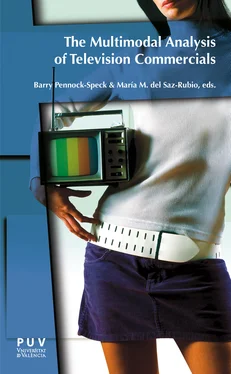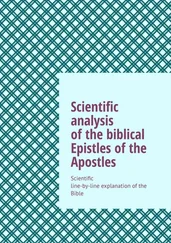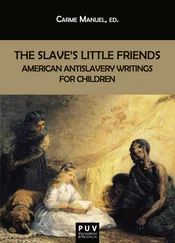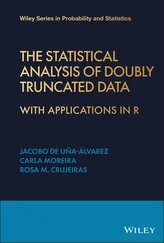This ad is clearly directed at men, but female characters, such as the girl in the example above, also appear as do characters whose gender is quite ambiguous (10, 15 and 19 seconds into the ad) thus causing a certain amount of confusion. It seems that everyone is invited to transgress what is socially accepted, that is, there is a certain laisser-faire atmosphere. Ultimately, it is the female gaze (28 and 35 seconds into the ad) that tells us that it is only by being true to oneself that we can be what we want to be.
6
Conclusions
This chapter has shown that television advertisements broadcast on TV3 do not differ substantially from those found on other Spanish television channels, whether they are of a generalist nature or not. Therefore, my results do not point to any significant differences between a hypothetical Catalan advertising model posited at the beginning of my article and that of other TV channels in the rest of the Spain. However, “an empty sign only acquires an identity within the act of communication itself which is the strategic axis of the symbolic production of the advertising industry” [my translation] (Gavaldà, 2004: 126). That is, although we cannot conclusively argue for the existence of an entity that represents a real world object and which differs from others unequivocally, we have seen characteristic elements that could support a hypothetical Catalan advertising model.
Advertising agencies do not use different techniques to create ads in Catalan; the articulation of meaning that takes place through narrative and narratological process is the same as for other TV channels. Nor are there different procedures in relation to the origin of most of the common discourse referents used, production costs of the advertising capsule, or the length of the ads. What we do see is that nuances are introduced through language, geographical locations, and some clichéd references.
Although we may not agree, today it is true that in an increasingly globalized world advertising models are also required to reflect this fact. The uniformity of referents, the standardization of communication strategies and the exaltation of the same corporate values: individuality, consumption, canons of beauty, etc. is necessary for the creation of universal discourses.
It is true that Kilian Jornet is a very important symbol of Catalan identity, but we cannot forget that he is an athlete in a sport with an English name, in a context of global competition. We could argue that the Sitges Festival is an international symbol of the Catalan film industry, but it is also undeniable that it has subsumed the aesthetic of American terror films. We might think that a symbol as Catalan as the sparkling water of the Caldes de Malavella would be imperturbable, but it needs referents that are not tied to any concrete social or geographical reality for discourse to be articulated, and so on. Emotionally we are heading towards a society modelled on consensus on certain undeniable and unquestionable values (Llorca-Abad, 2011: 145). In this sense, if we want to sell beer or products to deworm pets we can do so by using the same language, English, worldwide, thus relegating everything else to an anecdote.
In spite of all this, the normalizing influence of Tv3 regarding language and culture within Catalonia itself has been a determining factor in making the existence of television broadcasting in Catalan –including advertising discourse– a felicitously unremarkable everyday fact of life. Private companies and other entities understand that nowadays in order to sell they must also make use of local culture. This is what makes advertising on Tv3 both a force for globalization and, at the same time, a reinforcement of national identity. Therefore, advertisers and academics still have to avail themselves of some of the old referents, be they political, geographical, social, cultural, or economic to understand just what makes advertising in Catalonia similar but somehow different to other places in the world.
Appendix
Abbreviations found in Baldry and Thibault ( 2006 )
| T . column. |
| Refers to time in ad in which images appears. |
| Frame column |
| Image capture corresponding to the time in T. column . |
| Image column |
| CP. Camera Position , HP. Horizontal Perspective , D. Distance , VC. Visual Collocation , VS. Visual Salience , CO. Coding Orientation , CR. Colour , VF. Visual Focus |
| Kinetic action column |
| Brief description of action |
| Sound Track column |
| [♫] Presence of musical instruments |
| (*) Indicates that the music marks stress when it goes down or remains the same ( roll ). |
| (**) Indicates that the music marks stress when it goes up (volume might increase). |
| These indicators are also used to refer to male and female voice overs. In this case the text that is being heard is indicated. |
| Interpret. Phases and Sub-phases column |
| EXP. Experiential , INT. Interpersonal , TEX. Textual , LOG. Logical |
| Music |
| (pp.) very soft , (p.) soft , (n.) normal , (f.) loud , (ff.) very loud . If these appear together, that is, “pp., f”, it indicates fluctuation in volume. |
| Voices |
| [☻♂] [☻♀] Indicates male or female voice-overs respectively |
| Vol. stands for volume of the voice. It combines with volume indicators seen above, i.e., pp., p., n., etc. |
| Temp. stands for tempo or voice speed. It combines with the following: s. Slow , n. Normal , m. Median , f. Fast |
| Singers |
| [♫ ♂] Male singer [♫ ♀] Female singer |
| [♫ chorus] Male and female singers. It combines with the volume indicators for volume: n. Normal , m. Medium , l. Loud |
| Y for direction: > y < |
| Other sounds |
| [☼] Indicates sounds other than voice or music –includes silence. |
References
AGEP and FNEP (2009). Radiografía de la Industria Publicitaria en España . Madrid: Asociación General de Empresas de Publicidad.
Añaños, Elena. 2011. ‘Impacto visual y fijación ocular de la publicidad no convencional’. Quaderns del CAC XIV 37 : 83-95.
Baguet, Josep Maria. 2003. La Nostra. Vint Anys de Tv3 . Barcelona: Proa.
Baldry, Anthony and Thibault, Paul J. 2006. Multimodal Transcription and Text Analysis . London, Equinox.
de Vicente, Aída María. 2011. ‘Internet renueva el sector de la comunicación audiovisual’. Telos 87 , Abril-Junio. < http://sociedadinformacion.fundacion.telefonica.com/DYC/TELOS/REVISTA/Dossier/ DetalleArtculoTELOS_87TELOS_DOSSIER4/seccion=1266&idioma=es_ES&id=2011051111580001&activo=6.do> (Accessed September 2012).
DOGC (1983). ‘Llei 10/1983 de Creació de l’Ens Públic Corporació Catalana de Ràdio i Televisió’. Diari Oficial de la Generalitat de Catalunya 337, 1.480-1.484.
DOGC (2006). ‘Llei 22/2005 de la Comunicació Audiovisual de Catalunya’. Diari Oficial de la Generalitat de Catalunya 4.543, 84-106.
DOGC (2007). ‘Llei 11/2007 de la Corporació Catalana de Mitjans Audiovisuals’. Diari Oficial de la Generalitat de Catalunya 4.990, 37.773-37.787.
Читать дальше











